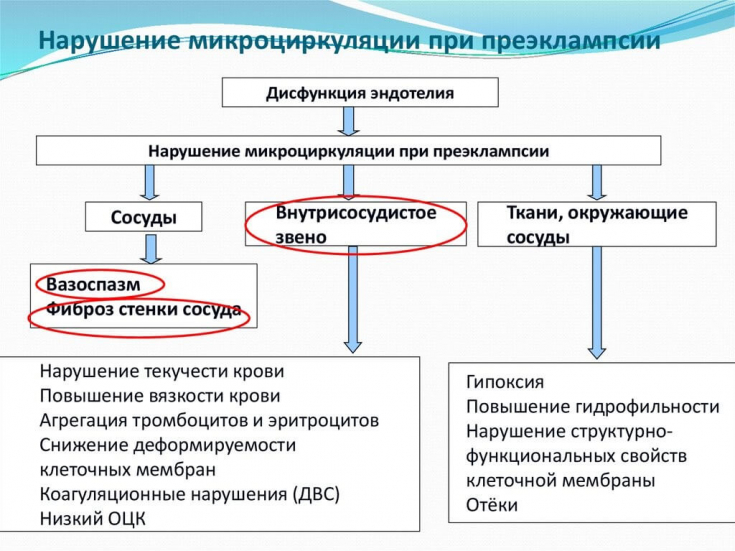Preeclampsia belongs to pregnancy complications and is characterized by the simultaneous development of hypertension and proteinuria. This pathology affects 2-5% of pregnancies and is the main cause of perinatal, neonatal and maternal morbidity and mortality.
Preeclampsia can develop from the 20th week of pregnancy and last up to 6 weeks postpartum. Preeclampsia is associated with risk factors for the metabolic syndrome, including insulin resistance and obesity.
Therefore, it is so important to prevent this process and avoid the negative effects of preeclampsia on both the pregnant woman and the child. Read about the main causes of this pathology at estet-portal.com
- The role of adipose tissue hormones in the development of preeclampsia
- The placenta and development of preeclampsia
- The secretory function of adipocytes and their role in the occurrence of pre-eclampsthese
The role of adipose tissue hormones in the development of preeclampsia
Women with preeclampsia have an increased risk of developing cardiovascular disease, a relatively high risk of hypertension, coronary heart disease, stroke, and venous thromboembolism. Decrease in uterine perfusion pressure during pregnancy is an important initiator of preeclampsia.
Follow us on Instagram!
Adipose tissue hormones play an important role in the development and completion of preeclampsia. Thus, the level of leptin mRNA is increased in the placenta in women with preeclampsia compared with healthy pregnant women. In addition, most studies have shown an increase in the level of circulating leptin in preeclampsia even before the clinical onset of the disease.
Y. Ning et al showed that plasma leptin levels at 13 weeks of gestation were 78% higher than in the first trimester in 55 patients with subsequent preeclampsia compared with healthy pregnant women.
Every 10 ng/mL increase in leptin is associated with a 30% increased risk of pre-eclampsia.
Leptin inhibits the apoptosis of trophoblastic cells that occurs during preeclampsia. Because leptin is a powerful factor in angiogenesis, an increase in its placental level can, along with other factors such as vascular endothelial growth factor (VEGF), lead to an increase in blood flow to the placenta through neovascularization.
Based on these findings, the authors hypothesize that hyperleptinemia in preeclampsia isa compensatory response to increased delivery of nutrients to the placenta.
The placenta and development of preeclampsia
Adiponectin also belongs to the hormones of adipose tissue and is involved in the pathogenesis of obesity. During pregnancy, maternal secretion of adiponectin mRNA in white adipose tissue gradually decreases by 60%. Adiponectin concentration has a negative correlation with the amount of fat mass.

In the umbilical vein, the concentration of adiponectin is higher than in the mother's serum. In addition, there is evidence of an increase in plasma levels of adiponectin with increasing gestational age and reaching its concentration by more than 20 times at 24 weeks of gestation.
One time caesarean section – always caesarean section: is it true?
Given these data, it can be assumed that the placenta is the source of adiponektina.
Secretory function of adipocytes and their role in preeclampsia
Resistine − peptide hormone, also known as adipocyte-specific secretory factor. Secreted by monocytes, macrophages and adipocytes. Both in vitro and in vivo, resistin reduces glucose tolerance, causing insulin resistance.
Resistin is synthesized in the human placenta mainly in trophoblast cells, and its gene expression in placental tissue is more noticeable compared to the chorionic tissue of the first trimester of pregnancy.
Plasma levels of resistin are significantly higher in pregnant women than in non-pregnant women, and circulating concentrations of this adipocytokine increase with increasing gestational age.

Visfatin − protein with a molecular weight of 52 kDa in visceral fat. Its plasma level increases with the development of obesity. In women of normal body weight, the peak plasma concentration of visfatin occurs between 19 and 26 weeks of pregnancy.
Visfatin is expressed by fetal membranes, secreted by amniotic epithelial cells during pregnancy, and has anti-apoptotic properties.
In addition, the use of recombinant human fetal membrane visfatin resulted in a significant increase in inflammatory cytokines, including IL1, TNF and IL6.
How to recognize an abdominal pregnancy? Tactics of diagnosis and treatment
So, adipocytes are involved in many physiological processes, which can lead to complications during pregnancy. Over the past few years, the role of leptin and adiponectin in the development of preeclampsia has been elucidated more.
However, the physiological significance of these adipocytokines in the pregnancy complications described above, as well as the possibility of using them as markers of pregnancy complications, remains the subject of clinical research.
The most up-to-date information on our YouTube channel:







Add a comment